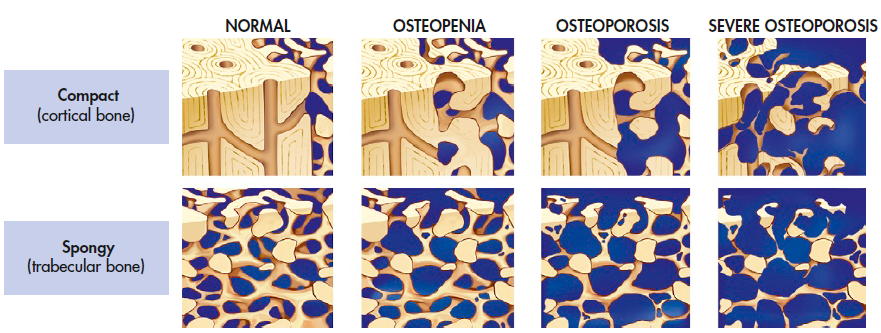Osteoporosis
Content of This Page
1- Introduction
2- Causes
3- Symptoms
4- Stages of The Disease
5- Treatment
6- What Should You Avoid
Introduction
Osteoporosis is a condition characterized by weakened bones that are more susceptible to fractures and breaks. It occurs when bone density decreases, leading to a loss of bone mass and deterioration of bone tissue. This makes bones fragile and more likely to break from minor falls or injuries. Osteoporosis is often called a “silent disease” because it can progress without symptoms until a fracture occurs. It is more common in older adults and can be influenced by factors such as age, gender, and lifestyle.

Causes
1. Aging:
- Bone Loss: Bone density naturally decreases with age as bone remodeling slows down.
2. Hormonal Changes:
- Menopause: Decrease in estrogen levels in women, leading to accelerated bone loss.
- Andropause: Decrease in testosterone levels in men, which can contribute to bone loss.
- Thyroid Disorders: Excess thyroid hormone can lead to bone loss.
3. Genetics:
- Family History: A family history of osteoporosis or fractures can increase risk.
4. Nutritional Deficiencies:
- Calcium Deficiency: Inadequate calcium intake affects bone formation.
- Vitamin D Deficiency: Necessary for calcium absorption and bone health.
5. Lifestyle Factors:
- Sedentary Lifestyle: Lack of weight-bearing exercise can lead to weaker bones.
- Smoking: Tobacco use can decrease bone density and impair bone healing.
- Excessive Alcohol Consumption: High alcohol intake can interfere with bone remodeling and calcium absorption.
6. Medical Conditions:
- Chronic Diseases: Conditions like rheumatoid arthritis, chronic kidney disease, and gastrointestinal disorders can impact bone health.
- Endocrine Disorders: Conditions such as Cushing’s syndrome or hyperparathyroidism can lead to bone loss.
7. Medications:
- Long-Term Steroid Use: Corticosteroids can decrease bone density.
- Certain Medications: Drugs used for cancer treatment or other conditions may affect bone health.
8. Eating Disorders:
- Anorexia Nervosa: Can lead to low bone density due to poor nutrition and hormonal imbalances.
9. Gender:
- Women: Generally at higher risk due to lower peak bone mass and hormonal changes during menopause.
10. Body Type:
- Low Body Weight: Individuals with lower body weight or small frame size may be at higher risk.
Symptoms
- Fractures: Broken bones from minor falls or injuries, commonly affecting the spine, hips, and wrists.
- Back Pain: Pain caused by fractured or collapsed vertebrae in the spine.
- Loss of Height: Gradual loss of height over time due to spinal compression fractures.
- Stooped Posture: A hunched or bent posture resulting from vertebral fractures.
- Bone Tenderness: Discomfort or pain in bones or joints, particularly after a minor trauma.
- Decreased Mobility: Reduced ability to move or perform daily activities due to pain or fractures.
- Kyphosis: An exaggerated curvature of the upper spine, also known as a “dowager’s hump,” caused by spinal fractures.

Stages of The Disease
1. Early Stage:
- Bone Density Loss: Gradual decrease in bone density, often detected through bone density tests.
- Asymptomatic: May not present noticeable symptoms; bone loss occurs without obvious signs.
2. Moderate Stage:
- Increased Fracture Risk: Higher risk of fractures from minor falls or injuries.
- Back Pain: Pain may begin to develop due to early vertebral fractures.
- Decreased Bone Strength: Bone density continues to decline, leading to increased fragility.
3. Advanced Stage:
- Frequent Fractures: Increased incidence of fractures, particularly in the spine, hips, and wrists.
- Significant Back Pain: Persistent or severe back pain from spinal fractures or deformities.
- Height Loss and Posture Changes: Noticeable loss of height and a stooped posture due to spinal compression fractures.
- Reduced Mobility: Difficulty in performing daily activities and increased risk of disability.
4. Severe Stage:
- Multiple Fractures: Frequent fractures with minimal trauma, potentially leading to severe functional impairment.
- Severe Kyphosis: Pronounced curvature of the spine, leading to significant physical deformity and discomfort.
- Complications: Potential for complications such as chronic pain, immobility, and increased risk of further fractures
Treatment
1. Medications:
- Bisphosphonates: Help prevent bone loss and increase bone density (e.g., alendronate, risedronate).
- Selective Estrogen Receptor Modulators (SERMs): Mimic estrogen’s protective effects on bones (e.g., raloxifene).
- Hormone Replacement Therapy (HRT): Estrogen therapy for postmenopausal women to slow bone loss.
- Calcitonin: A hormone that helps regulate bone metabolism and may reduce bone loss.
- Denosumab: A monoclonal antibody that slows bone resorption.
- Teriparatide: A parathyroid hormone analog that stimulates new bone formation.
- Romosozumab: A medication that increases bone formation and decreases bone resorption.
2. Lifestyle Changes:
- Diet: Increase intake of calcium and vitamin D through diet or supplements to support bone health.
- Exercise: Engage in weight-bearing and muscle-strengthening exercises to improve bone density and balance.
- Avoid Smoking: Smoking can decrease bone density and increase fracture risk.
- Limit Alcohol: Excessive alcohol consumption can negatively affect bone health.
3. Fall Prevention:
- Home Safety: Modify living spaces to reduce fall risks (e.g., remove tripping hazards, install grab bars).
- Balance and Strength Training: Exercises and physical therapy to improve balance and strength, reducing the risk of falls.
4. Bone Density Monitoring:
- Regular Screening: Periodic bone density tests to monitor bone health and adjust treatment as needed.
5. Pain Management:
- Medications: Over-the-counter pain relievers or prescribed medications to manage bone pain.
- Physical Therapy: To help with pain relief and improve mobility and function.
6. Surgical Interventions:
- Fracture Repair: Surgical procedures to repair fractures and manage severe cases of osteoporosis.
- Vertebroplasty/Kyphoplasty: Minimally invasive procedures to stabilize fractured vertebrae and reduce pain.
7. Patient Education:
- Understanding Osteoporosis: Educate patients about the condition, treatment options, and lifestyle changes to manage bone health effectively.
What Should You Avoid
- Excessive Alcohol Consumption
- Smoking
- Sedentary Lifestyle
- High-Sodium Diet
- Excessive Caffeine
- Crash Diets
- Overuse of Certain Medications
- Inadequate Calcium and Vitamin D Intake
- Poor Posture and Improper Body Mechanics
- Ignoring Fall Prevention Measures
- High-Impact Activities